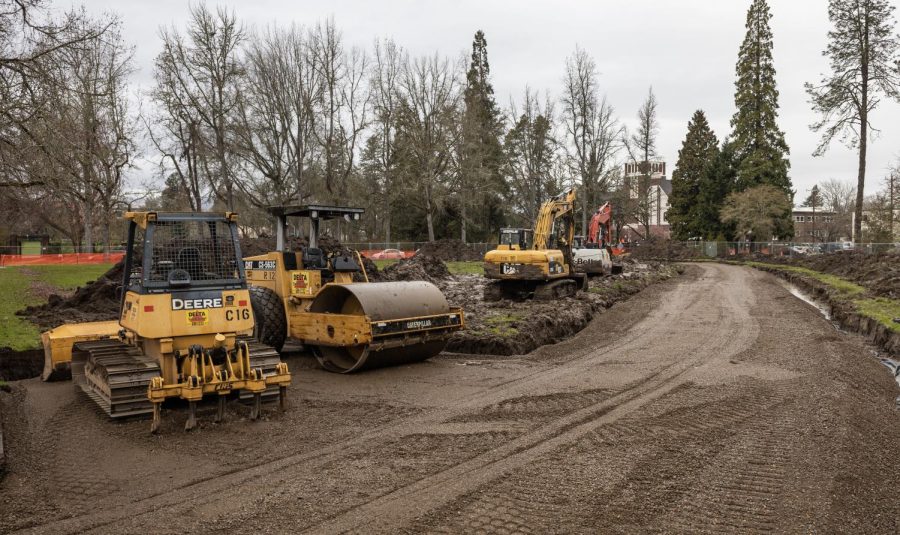OSU’s new upper-classman residence hall met with mixed community reception
The construction site of the upcoming graduate student resident hall located at the corner of SW 11th St. and SW Madison Ave. on April 5. The building is expected to be completed around June or July of next year.
April 10, 2023
Graduate students and upperclassmen will have expanded housing options starting in the fall term of 2024, after a new residence hall is built on the corner of 11th and Madison Avenue.
Oregon State University is finalizing building permits with the city of Corvallis and plans to break ground for a new, five-story residence hall soon, despite pushback from individuals of the Corvallis community.
The project will cost $56 million – $6 million of which will be funded by reserve funds held by University Housing & Dining Services and the remaining $50 million being funded by revenue bonds issued by the university – and will take 15 to 16 months to complete, according to UHDS Associate Director Dave Craig.
The bonds will be repaid through revenue generated by the new building, Craig said.
“This residence hall is conceived to house 221 upper-division and graduate students living in a blend of studio and two-bedroom units,” Craig said.
Fences have been put up on the block east of McNary Field in anticipation for Fortis Construction to begin the project, but it comes with mixed reactions.
“(UHDS) has conducted multiple market studies over the past 10 to 12 years using outside firms,” Craig said. “The studies have consistently shown a need for additional housing for upper division and graduate students.”
Though, since 2019, community members have opposed the construction of the residence hall. One, in particular, is Corvallis-based attorney Ron Marek, who objects to the construction, as it is occurring on a state-designated wetland, among other reasons.
“I withdrew from contesting the destruction of the wetland,” Marek said. “When I withdrew… the fences went up and staging the construction has begun.”
Marek said that OSU “has already destroyed” historic neighborhoods in Corvallis, and has contributed to the problem of inadequate accessible parking for Corvallis residents, both on-and-off campus.
“A worker at the Day Care Center across Madison has indicated that sometimes their workers have to walk seven blocks to work,” Marek said. “And that is before several hundred people, potentially with vehicles and few parking spaces, move in across the street.”
Marek pointed out that two graduate student associations — the Fisheries and Wildlife Graduate Student Association and Coalition of Graduate Employees — opposed the project as soon as it was announced, as well.
“Projected rent was (at first) $1,200 or $1,250… now the university says it will be up to $1,500,” Marek said. “That is ridiculous if the university has any intent to keep educational costs for attending college reasonable… I believe housing rent is an income generator for the University and it will charge whatever it thinks it can get.”
Craig said OSU does not anticipate parking issues for future residents of this hall.
“In addition to the 34 spaces being built on the site, parking for hall residents is available at several nearby locations,” Craig said. “This site is significantly served by fare-less public transit operated by OSU and the city of Corvallis (and) is within walking distance of downtown Corvallis and the center of the OSU campus… we believe is not auto dependent.”
Craig said that the residence hall, like other new housing developments in Corvallis, will emphasize walking, transit, biking and carpooling; which is in keeping with state of Oregon guidelines, city of Corvallis community goals for sustainability, and the university’s Pathway to Carbon Neutrality plan.
George Heilig, another Corvallis-based attorney who opposes the new residence hall, said OSU is failing to protect the iconic entrance to the lower campus.
“No matter how well designed, the mass of the building will diminish the pastoral approach to our land grant university,” Heilig said.
Marek resents the fact that OSU changed its construction plan which initially proposed two smaller dormitories on the same plot of land, after, he claimed, OSU learned that it could not cross utilities between the proposed buildings because of the Protected Vegetation Area designation between the two.
“OSU makes decisions, then tries to sell the decision to the neighborhoods, and if that fails it pushes its decisions, good or bad, through the system… There is no collaboration in the true usage of that word,” Marek said.
Craig said OSU has completed all of the city’s necessary land use processes and that the city’s approval of the building’s construction has been upheld at all appeal levels.











































































































